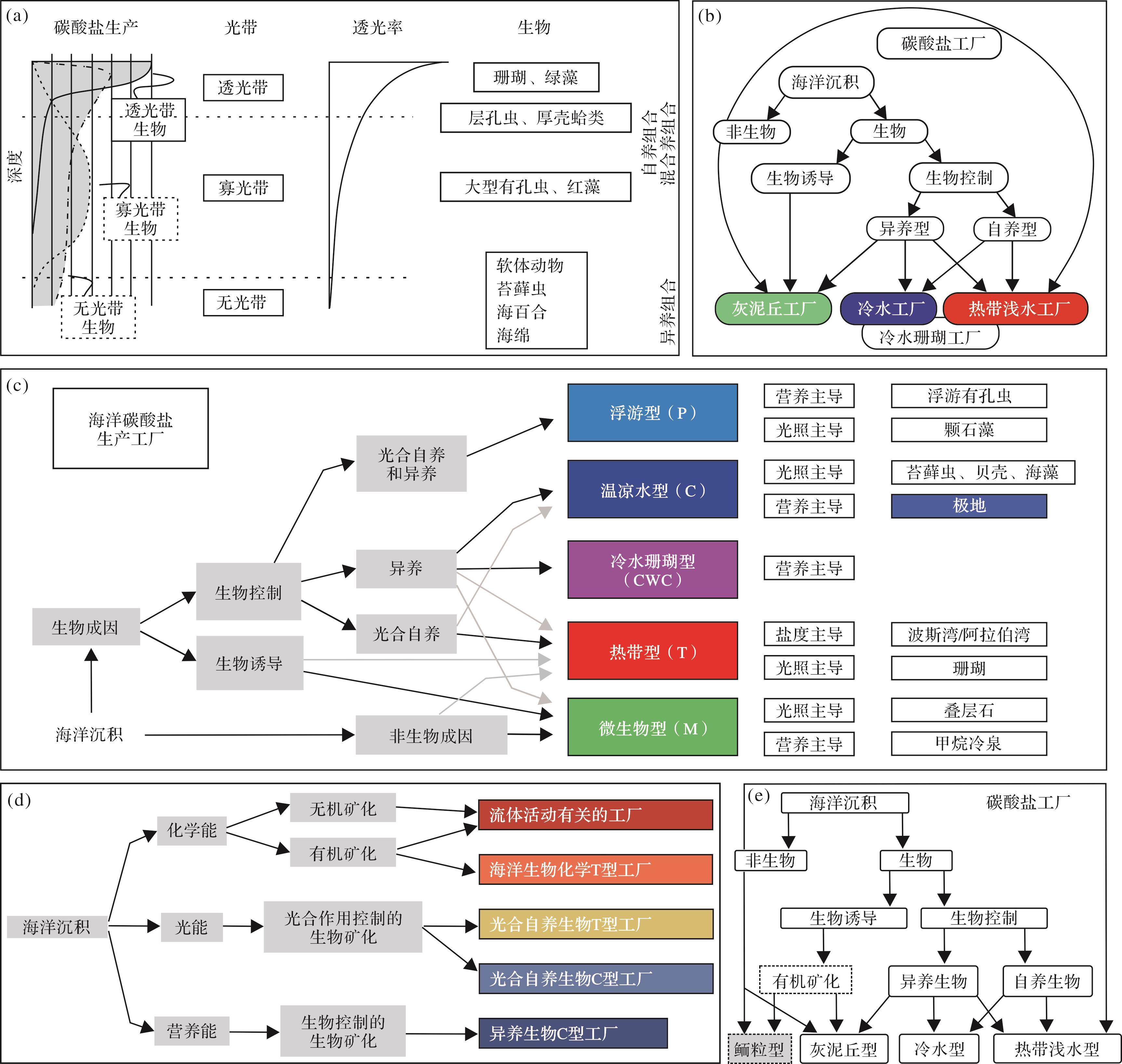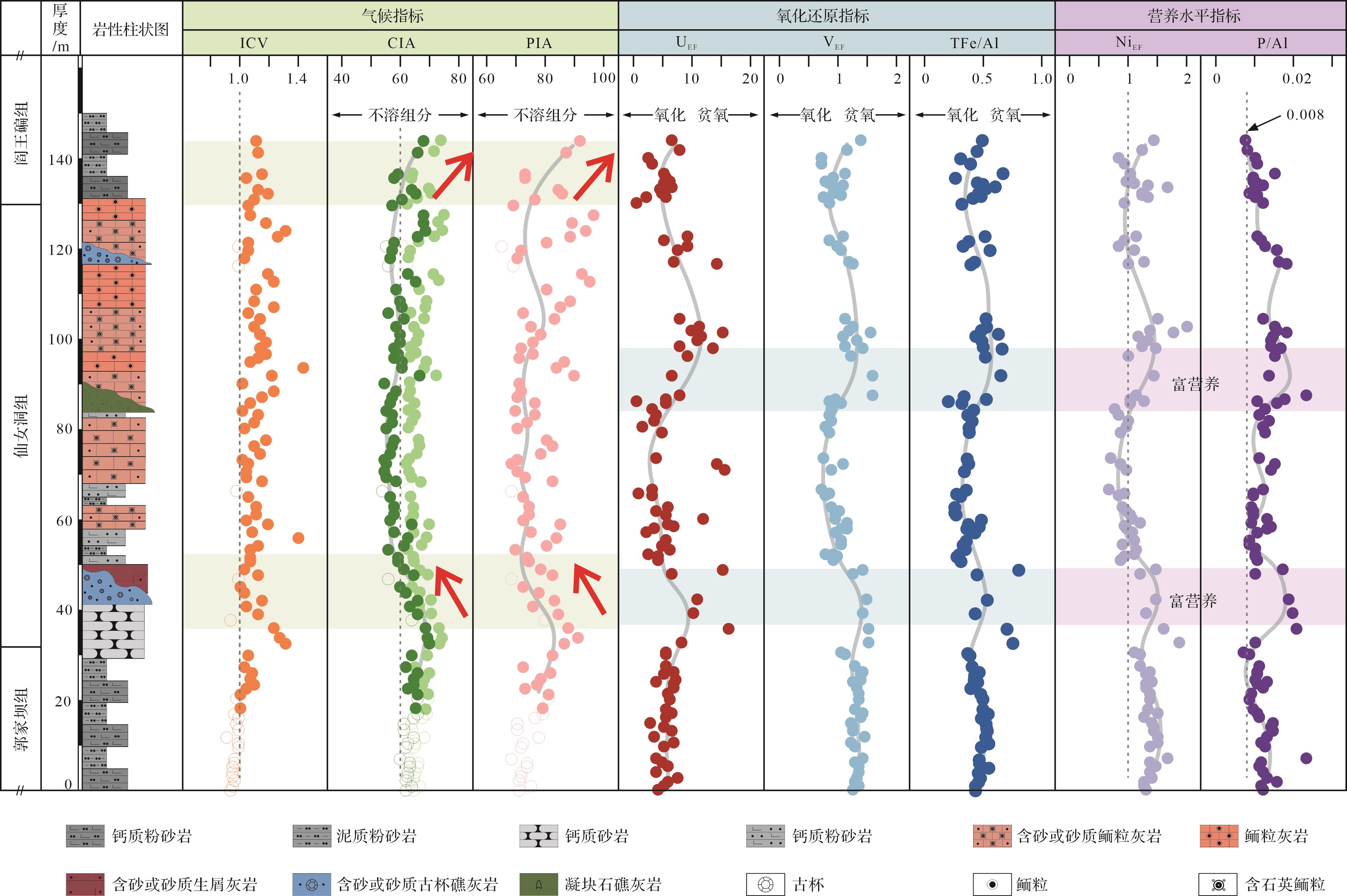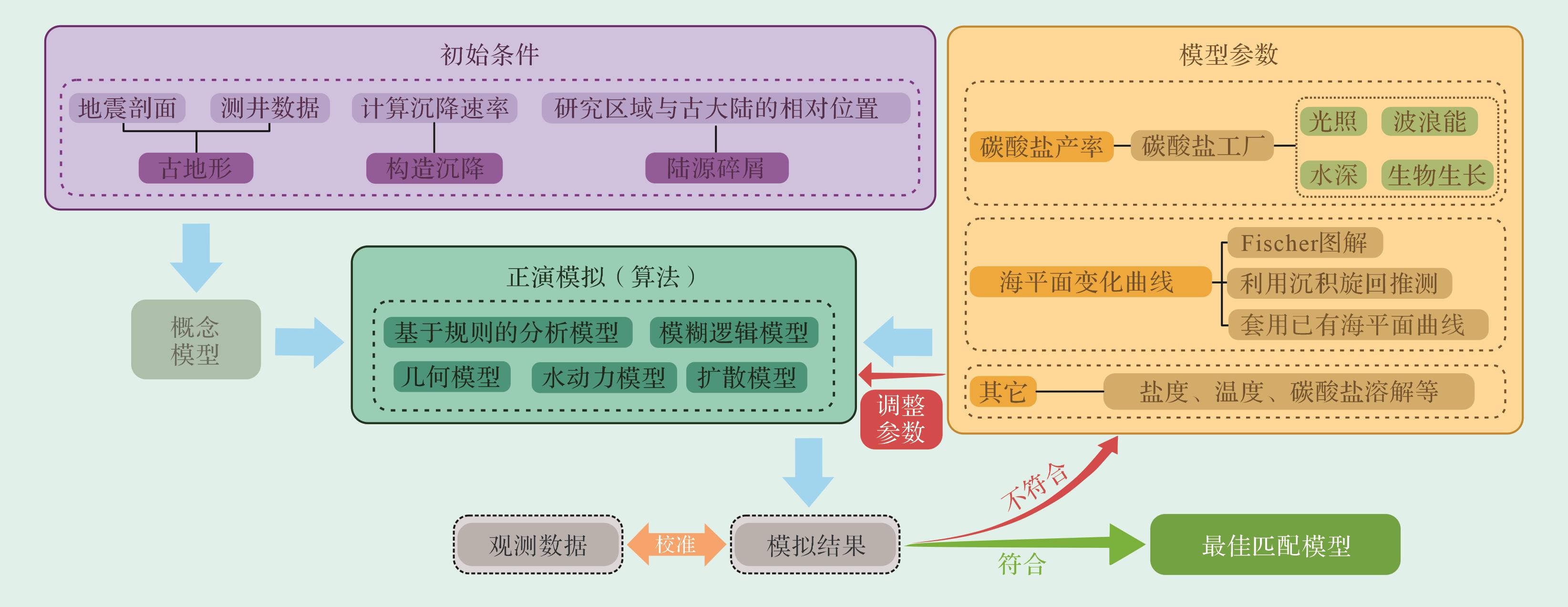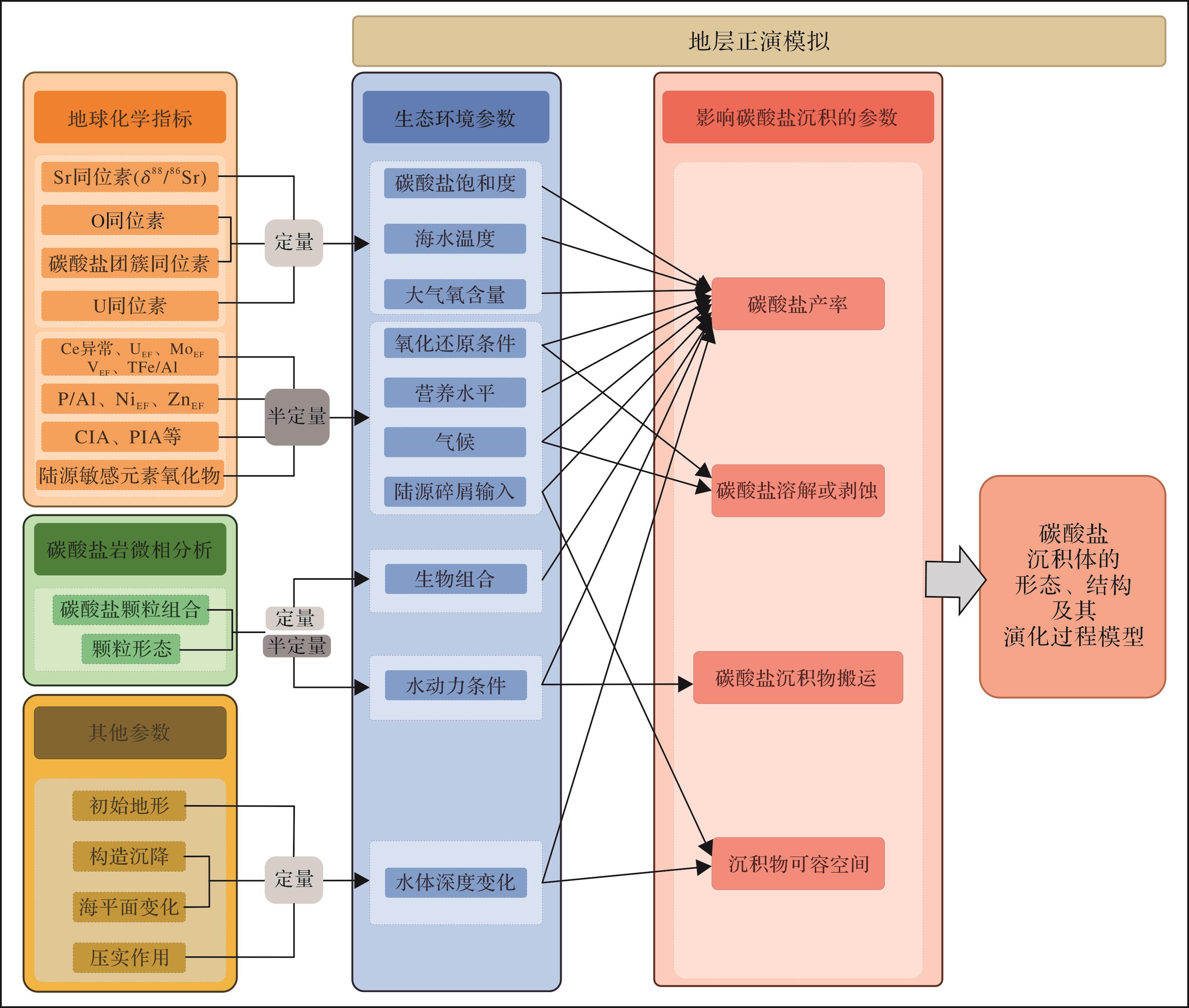HTML
-
由于碳酸盐岩的生源性,适宜光合作用生物生存的浅海区域具有较高的生物产率,是主要的碳酸盐生产场所,研究者称之为“碳酸盐工厂”[1]。近年来,碳酸盐工厂(碳酸盐生产工厂)研究的兴起加深了人们对于碳酸盐沉积物在三维空间内的形成、搬运,以及沉积过程的认识。此前针对碳酸盐工厂的讨论主要集中于碳酸盐工厂的模式及概念体系。其中,最具代表性的包括以沉积环境及其对应的沉积方式为研究对象的Schlager工厂模式[2⁃3],和以生态环境对工厂的影响为切入点的Pomar工厂模式[4⁃6],碳酸盐工厂概念体系也在Schlager和Pomar等前人的基础之上基本建立,但如何进一步挖掘工厂研究的价值以及指导沉积学创新方面还有待深入探讨(图1)。

Figure 1. Different research focused between traditional sedimentology and carbonate factory (modified from reference [7])
不同类型的碳酸盐工厂对碳酸盐岩沉积体形态和规模的影响一直以来受到广泛关注[3⁃5,8⁃11]。随光照和营养条件的改变,不同的光合自养生物(photozoan)和异养生物(heterozoan)组合的钙化速率会产生变化,从而影响不同水深的碳酸盐颗粒生产速率[4,6,12]。与此同时,碳酸盐颗粒从台地内部向外输送的速度会随着台地边缘及台地斜坡的形态、水流速度、风向、受海水饱和度控制的成岩固结速率等条件的变化而变化[8⁃9,13]。近年来,有研究者将上述基本原理结合正演模拟技术,对新生代以及古老的碳酸盐岩台地演化过程进行了恢复,发现不同类型的碳酸盐工厂具有不同的碳酸盐沉积物的产生速率、深度分布以及粒度(影响沉积物的抗侵蚀性),从而对碳酸盐岩台地几何形态的差异产生了关键性的影响[14]。
另一方面,碳酸盐工厂的转变往往与重大地质历史事件耦合。例如:从前寒武到显生宙记录了多次和重大地质历史事件有关的微生物主导的生物沉积体系和后生动物主导的体系之间的转换过程[15];P/T之交极热事件,缺氧事件,海洋酸化等极端环境变化使得浅水碳酸盐工厂崩溃,向鲕粒,微生物岩,以及自生泥晶为主的碳酸盐工厂发生转变[16⁃17];中二叠世生物灭绝事件及同期发生的环境剧变(如峨眉山大火成岩省火山喷发)可能严重打击了热带浅水碳酸盐工厂,使碳酸盐岩台地发生萎缩[18];晚三叠世卡尼期洪泛事件(CPE)使得特提斯域广泛发育的浅水微生物碳酸盐工厂快速转换为骨屑—鲕粒碳酸盐工厂,但在CPE之后又得到恢复[19]。由上可知,碳酸盐沉淀过程对于环境变化是十分敏感的,这一特性使得碳酸盐工厂的转变可以作为沉积环境发生重大转变的表征之一。因此,对于深时记录中的碳酸盐岩台地演化、碳酸盐工厂演化进行数值模拟,并探索其和重大地质历史事件的耦合关系及机制,具有深远的研究意义。
针对碳酸盐工厂的特征进行定性描述,根据生物、碳酸盐颗粒类型、岩相等划分工厂类型,并探讨随时间变化的工厂演化序列,可以帮助我们理解宏观尺度上碳酸盐工厂的转化过程及其与地质事件的耦合关系。但半定量、定量的碳酸盐工厂研究的缺乏,以及对碳酸盐工厂空间上的分布及转换的认识不足,使得我们对于碳酸盐工厂的时空演化及其主控因素等仍缺乏深入理解。因此,针对碳酸盐工厂的研究亟需从定性描述转向半定量—定量的精细刻画,而近年来测试分析手段以及沉积过程数值模拟方法的进步为此提供了良好的着力点。为此,首先总结了碳酸盐工厂及其主控因素的沉积学及地球化学定量表征方法,并介绍了利用碳酸盐岩沉积过程正演模拟进行碳酸盐工厂研究的进展,以期从定量化重建的视角,利用沉积学、地球化学,以及数值模拟的方法,提供综合分析碳酸盐工厂的生产过程和主控因素的研究思路。
-
Schlager[2⁃3]与Pomar et al.[4⁃6]分别提出了碳酸盐工厂分类体系中最广为接受的两种分类方案,具有不同的分类规则和概念结构(图2a,b),近年来关于工厂分类的讨论也大多基于这两种经典方案(图2b~e)。Schlager[2⁃3]的碳酸盐工厂分类是基于工厂所在的沉积环境和产生碳酸盐沉积物的沉积作用类型来划分的;而Pomar et al.[4⁃6]认为某些生物化学作用通过不同的生物群或生物组合控制了工厂的发育,即生态因素对碳酸盐工厂类型产生了巨大的影响。这两种分类方法为碳酸盐工厂研究提供了不同的视角,有助于我们更全面地理解碳酸盐岩沉积过程的复杂性。
Lowenstam et al.[22]提出的碳酸盐三种不同的沉积模式为Schlager[2⁃3]建立碳酸盐工厂的分类方案提供了基础。Schlager[3]认为海洋碳酸盐生产过程首先分为生物和非生物两种类型,在与生物相关的碳酸盐生产过程中又包括生物诱导和生物控制两种不同的生产机制,而所有碳酸盐岩的大规模沉积都来源于上述生产机制有规律的组合,并呈现出三种主要的碳酸盐生产系统(工厂):以光合自养生物为特征的热带生产工厂、以异养生物为特征的温凉水生产工厂和以微生物和非生物沉淀为主导的灰泥丘生产工厂[2⁃3](图2b)。上述分类方案中的工厂类型均建立于底栖生态系统,因此,Schlager[23]又追加了浮游生产工厂。近年来,Reijmer[20⁃21]对Schlager的分类体系进行了梳理和补充拓展,增加了冷水珊瑚碳酸盐工厂(图2b,c),其中每个生产工厂都有着不同的属性,例如特定的环境参数,沉积物的产生和运移特点和沉积体的形态和坡度等。但是,Schlager及Reijmer修订的碳酸盐工厂分类体系也存在一些问题,例如地质历史时期常见的、以鲕粒为主的沉积,既不属于光合自养型生物主导的工厂,也不属于非生物成因的化学沉淀主导的工厂类型。考虑到鲕粒的形成与有机矿化过程和化学沉淀过程均存在关联[24⁃25],Li et al.[17]认为应针对这种特异性工厂类型单独分类为鲕粒工厂(图2e),而Michel et al.[10]认为应和其他几类共同构成生物化学工厂。
此外,Michel et al.[10]通过数值模拟对现代碳酸盐岩台地的全球分布规律进行了探索,他们发现不同类型的碳酸盐岩台地的分布并不是随机的,而是受台地中碳酸盐工厂的生产条件,也就是适宜碳酸盐颗粒沉淀的生态环境因素所控制和影响的。该研究根据现代海洋沉积定义了海洋生物化学T型工厂、光合自养生物T型工厂、光合自养生物C型工厂,以及异养生物C型工厂四种类型(图2d)及其对应的环境特征,其中的T型、C型工厂均参照了Schlager[23]提出的相关概念。此外,该研究也提到了自生灰泥工厂(M-Factory)、流体活动有关的工厂、冷水珊瑚工厂等概念。
Pomar et al.[4⁃6]则将工厂理论作为一个动态分析碳酸盐生产过程的工具,主要用于阐明生物过程和物理过程如何控制碳酸盐沉积体系[26]。Pomar et al.[6]基于生产过程和产物的关系,将海水中的Ca2+和大气中的pCO2的变化与海洋中进行碳酸盐沉淀的生物群落的演化和生态需求相结合,其基本原理在于CO2是碳酸盐沉淀和有机物生存的基础,而光合作用则是主要的有机物生产过程,同时也为钙化作用提供了必要的化学环境。Pomar[4]将水体按照光照条件划分为透光带、寡光带和无光带,并对应不同的生物组合(图2a)。
因此,相对于Schlager[23](及Reijmer[21]修订)分类方案中提出的五种工厂类型及其中包含的与沉积环境之间的对应关系(如“热带浅水”等),Pomar et al.[6]提出的碳酸盐工厂模型和分类方案并没有强调特定环境与工厂类型之间的对应关系,而是突出了工厂中生态环境条件变化对碳酸盐生产过程及钙化机制的控制作用,即同一地理环境中,环境因素的改变可以影响工厂类型。综上所述,Pomar et al.[6]的模型及方案为定量化描述工厂的演化及环境因素之间的关系提供了更直接的立足点。
-
沉积相模式是对于现代及古代各类沉积体系的特征及其控制因素的概括总结[27]。针对碳酸盐岩的沉积相模式研究自Irwin[28]开始,在20世纪70至90年代达到顶峰。国内外运用最广泛的模式之一是Wilson[29]建立的碳酸盐岩镶边台地模式。在这一模式中,Wilson[29]在Flügel[30]总结的三叠纪常见的碳酸盐岩微相类型的基础上,提出了热带碳酸盐岩镶边台地中的9个标准相带模式(Standard Facies Model,SFM)及对应的标准微相类型(Standard Microfacies,SMF)。之后,Flügel[31⁃33]在大量前人研究的基础之上,建立了一套碳酸盐岩微相分析的综合方法,总结了现代和古代的典型碳酸盐岩沉积相模式,并划分出沉积相带及对应的标准微相类型,得到了广泛的应用(如金振奎等[34])。
以Flügel[31⁃33]为代表的微相分析方法是从碳酸盐岩的微观结构入手,定量/半定量地分析其中的颗粒(生物/非生物)组合、颗粒粒径、基质类型、结构构造及成岩特征等,通过与标准微相的对比,解读沉积及成岩信息,恢复岩石形成时的沉积相带和古环境。而通过识别不同成因的碳酸盐组分,并确定其含量和比例,可以识别出沉积序列中不同的碳酸盐生产模式及其所在环境[35⁃36],这与微相分析相似而又有所不同,因此碳酸盐工厂的研究更加强调不同组分的成因来反演碳酸盐生产的过程[2⁃3,21],更需要对古环境演化过程进行定量化解读[6]。虽然微相分析可对岩石组构进行细致和综合的分析,但通过微相分析手段得出的沉积环境信息通常只是定性的描述,无法定量化表征碳酸盐生产过程的控制因素。与此同时,化石保存的不完备性,或后期成岩改造对沉积及早期成岩作用信息的破坏,都可能导致微相分析对碳酸盐工厂的古环境条件的误读。
因此,在碳酸盐工厂的研究中,需要在传统的沉积相及碳酸盐岩微相分析的基础上,通过定量/半定量统计生物和非生物颗粒组合,结合有环境指示意义的矿物特征、沉积结构、地球化学指标,来更好地厘定碳酸盐岩形成时的古环境条件,如水深、光照强度、温度、营养水平、水体氧化还原状态等[12,21,33,37⁃41]。此外,定量分析沉积物的粒度、垂向变化等特征,也可以更准确地得出岩石的沉积物来源和沉积过程中的水动力条件,包括搬运距离、沉积速率、沉积物运移方式等[35,42⁃46]。而通过颗粒、基质、胶结物的类型和发育期次等特征,可以恢复成岩序列及成岩环境[47⁃50];同时,结合对地球化学信号有效性的评估[51⁃52]识别成岩作用对岩石结构组分及其记录的古环境信息的改造程度,可将真正反映碳酸盐生产及其主控因素的信息识别出来。
-
碳酸盐岩微相分析方法中把碳酸盐颗粒的统计作为定量化描述岩石物质组成的重要方法,定量的颗粒统计及分析不仅可以描述岩石的成分变化,也可以定量化地反映沉积环境特征[31⁃33]。在碳酸盐工厂的研究中,定量的颗粒统计也常被用来指示碳酸盐工厂类型的转化[19,53]。颗粒形态包括粒度、磨圆、分选等是确定古沉积环境的重要依据[43,54⁃55],可以反映水动力强度等指标,但现阶段对于碳酸盐颗粒形态的定量化描述及其指示意义仍需要进一步的理论研究及应用。
早在20世纪50年代,Ginsburg[56]就统计了佛罗里达南部具有良好海水循环的带状生物礁以及半局限的佛罗里达湾极浅水区域中的碳酸盐颗粒,分析后发现后者比前者含有更多的小于0.125 mm的细粒沉积物,而在大于0.125 mm粒径的沉积物中,前者含有丰富的藻类和珊瑚的碎片,后者则基本以软体动物和有孔虫为主,同时,在生物礁中随着深度和水循环的变化,动植物组合都发生了显著的变化,从而可以区分出三种具有不同颗粒组合和粒度特征的亚环境,证明了碳酸盐颗粒的粒度和成分与沉积环境有极大的关系。Braithwaite[57]在生物碎屑砂样品中筛分出1 000个颗粒,让它们分别在250 cm的海水柱中以终端速度进行自由无阻碍下落,并进行了单独测量、称重和计时,发现颗粒在下落过程中经历了四种状态:直线下落、旋转和螺旋下落,以及不稳定的翻滚,并发现随着颗粒尺寸的增加,所经历的四种下落状态的比例同时取决于颗粒的形状和有效密度。付坤荣等[58]通过统计4种颗粒滩的颗粒灰岩并绘制其粒度曲线,发现不同颗粒在平均粒径、分选性、滚动—跳跃—悬浮次总体的含量方面均有明显区别,其中台缘滩的水动力与前滨带接近,台内滩的水动力表现为中等能量的波浪扰动,指示其发育于受障壁的台地内部。郭芪恒[59]通过对北京西山下苇甸张夏组鲕粒的粒径统计,发现鲕粒粒度特征与鲕粒滩在空间上具有良好的耦合关系,因此鲕粒粒度特征可用于精细刻画鲕粒滩沉积水介质的能量变化。柳晶晶等[60]在研究川西北地区马鞍塘组的特异化碳酸盐工厂转换机制时,提到鲕粒、似球粒、包粒、生物碎屑具有不同的形成方式,并通过对不同颗粒进行粒径和形状(形状系数、圆度、凸度和扁平度)的定量统计,分析了形状和粒度的变化规律及其所反映的颗粒的搬运方式、水动力条件等。结果表明,似球粒粒径集中在65~272 μm,且颗粒的分选最好,扁平度接近2,以形状规则、磨圆较好的扁长形椭圆为主,其搬运方式主要为跳跃搬运,反映了中—高能水动力环境;鲕粒磨圆较似球粒更好,粒径介于285~351 μm,圆度为0.8~0.9,扁平度小于似球粒,搬运形式一般为滚动或跳跃搬运,反映了大于似球粒的水动力条件;生物碎屑颗粒极不规则,粒径最大可达7 mm,磨圆较差,且部分颗粒间由灰泥充填,可能代表一种水动力较小的环境。但在使用基于碎屑岩沉积体系所建立的颗粒形状及粒度与水动力相关关系的模型时,也需要注意生源性(biogenic)的碳酸盐颗粒与碎屑颗粒的差异,且急需建立基于碳酸盐颗粒的模型,de Kruijf et al.[61]的研究中也强调了生源性的碳酸盐颗粒比碎屑颗粒具有更复杂和广泛的形态、密度和磨蚀产物;因此,该研究建立了一个数据库,记录已发表的各种常见碳酸盐组分的颗粒沉降速度和密度,由于碳酸盐颗粒存在广泛的形态和密度变化,需要进行额外的系统性的针对成分的研究,以实现对碳酸盐颗粒水动力学的充分预测。
需要注意的是,在使用碳酸盐颗粒定量统计分析碳酸盐工厂所处环境的水体能量时,也需要结合早期成岩作用特征等对统计数据进行详细解读。例如阿布扎比沿海地区(波斯湾南部)发育的现代碳酸盐工厂,气候炎热干旱,降雨稀少,且陆源输入微弱[62⁃63],整体碳酸盐沉积代表现代边缘海碳酸盐缓坡,自陆向海可见萨布哈、潮坪、潟湖、颗粒滩及较深海沉积[64]。古地理分布对于萨布哈、潮坪、潟湖的水动力情况和沉积特征具有一定的控制作用。但除了松散碳酸盐颗粒沉积,阿布扎比沿海及其他波斯湾南部地区海底大范围出现现代硬底[64⁃65]。很多现代硬底(尤其向陆局限地区)具有较平整的上表面,并且生物钻孔和结壳少见,不同于传统认识中的古代硬底特征(表面不规则,生物钻孔和结壳明显)。研究表明,这些现代硬底的形态和内部早期海相碳酸盐胶结物组构(包括矿物和形态)呈现明显的空间变化,可能受控于海水性质、沉积环境和早期海相成岩作用中氧化还原界面波动[62]。因此,虽然Zhong et al.[66]通过颗粒观察和统计认为随着水动力减弱,沉积物粒度变细(泥质含量增加),但早期胶结作用有利于碳酸盐颗粒保存,并可能产生与水动力分布不符的沉积粒度特征[62],早期海相成岩作中,微生物活动和泥晶化过程会在一定程度上控制碳酸盐颗粒的形态和粒径[62⁃63],而受水体自身的碳酸钙饱和度所控制的早期海水胶结作用,可能将不同粒径的沉积物黏结在一起[67],产生与水动力环境相悖的颗粒分布特征。
-
在碳酸盐工厂的建造过程中,水体深度、氧化还原条件、营养水平、温度和盐度等,以及气候、陆源碎屑输入通量等指标都可能对工厂发育产生较大影响。传统研究主要通过岩石学、矿物学、具指向性的化石和沉积物等指标对碳酸盐发育过程中的环境变化进行识别。例如利用水柱中沉淀的草莓状黄铁矿的粒径变化特征指示海水缺氧和常氧条件的变化[68⁃70];利用全球范围低纬度地区鲕粒的广泛发育指示极端热室气候条件[17];煤层的广泛出现对湿润气候的指示,大规模异养生物群落的发育对富营养条件的指示[71]等。尽管这些指标极大地促进了我们对碳酸盐工厂发育环境的认识,但是这些认识无法提供可靠的定量分析数据,造成对工厂发育过程缺乏有效的量化评价方案。气候、环境和海平面变化等是调控碳酸盐工厂发育类型和规模的主要控制因素,通过连续对碳酸盐岩中相关元素指标的提取,有望定量重建工厂的建造过程。例如,碳酸盐组分中Ce异常,Zn/Fe摩尔比值,I/(Mg+Ca)等指标可用于连续追踪水体含氧量的变化;通过对滨海环境中混入的少量细碎屑组分进行分析,可获得气候、温度、营养水平等方面的线索。
Li et al.[72]以寒武纪早期上扬子北部地区为例(图3),研究围绕汉南—米仓山古陆发育的连陆台地,台地中形成了以鲕粒、钙质微生物,以及钙质微生物与古杯联合建造的多类型浅水碳酸盐工厂,由于该工厂类型代表着一种寒武纪早期独特的宏体生物、微生物和非骨屑碳酸盐复合建造工厂类型,了解其形成过程中动态变化的氧化还原条件、陆源输入情况、营养水平,以及气候条件等显得非常关键。该研究发现通过弱酸淋滤与碳酸盐组分共生的少量细碎屑组分后获得的化学蚀变指数、斜长石蚀变指数可重建浅水碳酸盐工厂发育的气候条件,两个指标均指示了工厂发育于相对干旱的气候背景条件;在排除碳酸盐组分稀释效应的基础上,P/Al和Ni富集因子显示鲕粒工厂的发育与营养水平的变化无直接关联,但微生物碳酸盐工厂更趋向于高营养条件且形成环境氧含量相对贫乏,而古杯主导的工厂类型营养水平相对较低。基于一系列元素地球化学指标,该研究推测浅水碳酸盐工厂的崩溃与当时气候转暖湿造成的陆源碎屑输入通量的显著增强、营养水平增加,最终将整个浅水碳酸盐工厂掩盖有关,并且由于持续长时间的恶劣环境导致工厂无法恢复而最终消亡。由此可见,元素地球化学指标可以对工厂发育过程的定量评价提供重要参考。

Figure 3. Quantitative reconstruction of climatic, environmental, and nutrient factors for the development of a tropical shallow⁃water carbonate factory in the Early Cambrian based on element geochemical indicators (modified from reference [72])
-
碳酸盐岩的同位素地球化学是研究碳酸盐工厂演化及其相应海洋环境的重要手段。目前应用最广泛的包括碳酸盐岩的碳、氧、锶同位素[73⁃75]。近年来,非传统金属稳定同位素(钙、镁同位素)也被开发用以示踪碳酸盐工厂的早期成岩过程,进而为解读其反映的古气候、环境信息提供更有效的评估[76⁃79]。针对碳酸盐工厂研究的传统同位素地球化学研究方法,近期已有文章进行系统总结[36],不再赘述。主要对近年来的一些新兴技术进行介绍,包括利用碳酸盐团簇同位素(Δ47,Δ48)重建古温度和利用Sr同位素(δ88/86Sr)新开发的碳酸盐岩饱和度指标。
温度是影响碳酸盐工厂发育的重要因素,因此古温度重建是碳酸盐工厂研究的重要方向之一。碳酸盐岩的氧同位素是最常用的“地质温度计”,但受限于有效载体的保存、成岩改造等因素的影响,除了基于弱成岩改造的生物壳体,如牙形刺磷灰石和腕足类方解石壳等得出的结果,利用全岩δ18O重建古温度一直饱受争议[80⁃82]。近年来,碳酸盐团簇同位素(Δ47)地球化学的快速发展[83⁃84],为古海洋温度重建提供了更有效的指标,并为传统的氧同位素定温方法等提供了可相互印证的对象,为探索碳酸盐工厂—生命—气候环境协同演化提供了新的机遇。Goldberg et al.[85]通过对比团簇同位素和氧同位素恢复的泥晶灰岩样品中不同组分的温度,发现早古生代碳酸盐全岩δ18O数据受到成岩改造的影响较小,且与腕足壳和牙形刺氧同位素结果有较好的一致性,并以此为基础选取数据恢复了全球寒武纪—奥陶纪的高分辨率温度记录,然后将其置于生物演化和全球构造运动的背景下进行对比研究,指出地球气候与构造和火山活动关系紧密,并控制早期生物演化。随着分析测试精度的提高,碳酸盐团簇同位素的测定从Δ47发展到Δ48,开展双团簇同位素(Δ47+Δ48)测温可以避免动力学分馏造成的偏差,实现古温度的有效重建[86⁃87],为碳酸盐团簇同位素研究开拓了新的方向。此外,Swart et al.[88]利用实验室合成方解石成功建立了首个团簇同位素Δ48的温度标定公式,展现出双团簇同位素测温的巨大应用潜力。需要注意的是,碳酸盐岩团簇同位素可能在埋藏成岩过程中由于溶解和重结晶作用丢失原始古海洋温度信号,从而反映成岩流体温度[89]。
碳酸盐饱和度控制碳酸盐的沉淀和分布[10,90]。Wang et al.[91]利用稳定Sr同位素(δ88/86Sr)开发了一种全新的碳酸盐岩饱和度指标,其基本原理是Sr同位素的分馏主要受碳酸钙沉积速率控制(动力学分馏),即海水碳酸钙饱和度的变化,为探索海洋碳酸盐工厂和碳酸盐矿物饱和状态的演化提供了新的视角。该研究对30亿年以来碳酸盐岩记录的稳定锶同位素进行了恢复,发现前寒武纪海相碳酸盐岩的δ88/86Sr值相较于显生宙显著偏高,根据Sr同位素分馏原理和同位素质量平衡计算,发现前寒武纪海洋的碳酸钙饱和度远高于显生宙海洋,提出前寒武纪海洋存在一个“被忽略的”碳酸盐工厂,如孔隙水中生成的自生碳酸盐,可能代表了整个前寒武纪一个主要却被忽视的碳酸盐汇。
利用碳酸盐岩的地球化学组成重建碳酸盐工厂及其海洋环境演化的基础是,碳酸盐岩能够忠实地记录原始海水的地球化学信号[73]。由于受到复杂的沉积—成岩过程的影响,碳酸盐岩的地球化学信号能否真实地反映海水信息一直备受争议[92]。近年来,越来越多的学者开始重视对碳酸盐岩所记录的地球化学信号有效性的评估[51⁃52]。碳酸盐岩Ca-Mg同位素体系被开发用来约束碳酸盐的原生矿物和早期成岩作用[76,79,92]。碳酸盐岩早成岩阶段的成岩体系可视为海水和沉积物两个端元的混合,不同深度的成岩流体性质受海水和沉积物孔隙水不同程度混合的影响,前人将两个端元分别描述为流体缓冲体系和沉积物缓冲体系[76,79]。流体缓冲体系形成的碳酸盐沉积物继承了海水较高的δ44Ca值特征;而形成于沉积物缓冲体系中的碳酸盐沉积物,由于继承原始碳酸盐矿物的Ca同位素值,具有较低的δ44Ca值[76⁃77,79]。在相对封闭的沉积—成岩体系中,碳酸盐岩的Mg同位素组成(δ26Mg)主要受到孔隙水的δ26Mg值分馏的影响。因此,根据Ca-Mg同位素体系分析可以约束沉积—成岩系统的开放性,这对评估其地化指标的受改造程度至关重要。Lau et al.[52]进一步利用水—岩反应模型对碳酸盐岩的古氧化还原指标I/Ca,Ce/Ce*,碳酸盐晶格结合态Cr、U、S同位素进行数值模拟,定量评估成岩改造对这些指标的影响。结果表明,由相对未演化的海水构成的成岩流体缓冲体系(“海水缓冲”)能够有效地保留所有的地球化学信息。相反,由在不同氧化还原条件下高度演化的孔隙水构成的成岩流体缓冲体系(“孔隙水缓冲”)可能改变原始的地球化学信号。为了更好地解读成岩作用对碳酸盐岩地球化学指标的影响,未来还需要更多的理论实验约束、野外观测和多地化参数综合数据集。
此外,受洋底板块俯冲作用的影响,现存大部分海相碳酸盐岩为古代陆表海沉积产物。古代和现代陆表海碳酸盐沉积研究表明,海水性质及相应碳酸盐地球化学记录与同时期广海性质有时会表现出很大的差异性[93]。例如Pederson et al.[93]对阿布扎比沿海地区海水性质进行了研究,发现随着沉积环境局限性增加,海水性质受到气候、沉积和早成岩环境中有机质分解的影响,从而与广海海水性质产生明显的差异性,这对研究古代边缘海碳酸盐岩地球化学性质具有重要意义。
2.1. 传统沉积相及微相分析与碳酸盐工厂研究的异同
2.2. 碳酸盐颗粒定量统计分析
2.3. 元素地球化学方法
2.4. 同位素地球化学研究方法
-
研究沉积体的三维演化过程,通常是基于露头或钻孔采集大量数据来进行多元地质统计建模(例如:Amour et al.[94]),但这种方法高度依赖于数据,所以只能在有限的程度上揭示影响沉积过程的地质规律。近年来基于地质过程的建模方法如地层正演模拟技术(Stratigraphic Forward Modelling,SFM)的进一步发展,为地质规律的验证和总结提供了更有效的思路[95]。
在碳酸盐岩沉积过程正演模拟中,需要调整各类参数以获得最符合实际情况的模型(图4)。在碳酸盐岩沉积过程正演模拟中使用的主要参数包括模拟区域的面积、初始地形、研究区构造沉降、全球海平面变化和沉积物供应等[96]。当物质来源稳定时,碎屑岩体系中的沉积物性质及沉积结构几乎是均一的,但由于碳酸盐岩沉积物的内源性(“carbonate are born, not made”[1]),即沉积物是由不同水深的“生产者”在原地产生,然后在波浪和重力的作用下被改造和运移的[97],所以碳酸盐沉积通常具有极强的非均质性。而碳酸盐工厂的概念为模拟碳酸盐沉积物的生产和搬运过程提供了理论支持。因此,在碳酸盐岩体系中运用基于沉积过程的地质建模方法时,除了考虑构造基底沉降、海平面变化、古地形、陆源碎屑输入、沉积物运移等因素,还需要关注由不同类型的碳酸盐工厂所控制的碳酸盐产率变化与其他环境因素的耦合关系(图4、表1)。例如,光照强度、温度、水深、波浪能和沉积物可容纳空间等因素均可以通过影响生物的生存状态从而间接影响工厂的发育[4,6]。虽然受限于现有模型及模拟方法,沉积过程正演模拟难以重建快速的环境变化所导致的碳酸盐生产及溶解过程,但在长时间尺度的研究中,将碳酸盐工厂及其演化过程纳入研究思路,可以深化对台地/盆地演化驱动因素的认识[101,117],进而深入揭示碳酸盐工厂在沉积过程中的重要作用。因此,对碳酸盐岩沉积过程进行正演模拟也是定量化厘定碳酸盐工厂及其主控因素的过程(图5)。
实例参数等 Al-Salmi et al.[98] Li et al.[99] van der Looven et al.[100] Tella et al.[97] Liu et al.[101] Barrett et al.[102] Burgess et al.[103] 段太忠等[95] 刘建良等[104] 黄渊等[105] 陆源碎屑 — — — — 基于钻井资料确定陆源碎屑输入的位置 — — — — — 温度 — — — — 利用氧同位素重建古海洋温度:T=16.9-4.2(δC-δW) +0.13(δC-δW)2[115] — — — — — 盐度 — — — — 利用碳氧同位素推算古盐度:Z=2.048(δ13C+50) +0.498(δ18O+50) — — — — — 沉积物搬运 简化的扩散方程:Q=Kwave×Ewave×S(Q:沉积物通量; Kwave:波浪扩散系数;Ewave:波浪能;S:坡度) 沉积物的搬运与地形坡度和扩散系数有关 简化的扩散方程:Q=Kgravity×S+Kwave×Ewave×S(Q:沉积物通量; Kgravity:重力扩散系数;Kwave:波浪扩散系数;Ewave:波浪能;S:坡度) 简化的扩散方程:Q=Kwave×S(Q:沉积物通量;Kwave:波浪扩散系数; S:坡度) — 利用剪切力和地形坡度模拟搬运过程:τtotal=τcurrent+τwave+τslope[116] — 基于扩散模型和水动力学方程 — 基于扩散模型和水动力学方程 时代 侏罗纪— 早白垩纪 早三叠世— 中三叠世 渐新世—中新世 中新世 晚埃迪卡拉世— 早寒武世 全新世 — 晚白垩纪 — 寒武纪 研究区 阿曼北部下白垩统碳酸盐岩台地 大贵州滩 马尔代夫群岛 Menorca岛碳酸盐缓坡 四川盆地中部德阳—安岳海槽 大堡礁 — 大巴哈马滩 — 塔河地区 沉积建造类型 镶边台地 孤立台地 孤立台地 缓坡 斜坡 孤立台地 分析海平面升降及碳酸盐产率对浅水不同岩相厚度的影响 孤立台地 台地—斜坡相(分析碳酸盐地层的完整性) 碳酸盐地层演化 软件 DionisosFlow DionisosFlow DionisosFlow DionisosFlow Sedsim CARBONATE 3D Dougal CARBSIM Sedsim iRDS-CarbSIMS 续表 Table 1. Study cases for carbonate sedimentary process modelling
-
碳酸盐的产率是决定碳酸盐工厂生产过程及碳酸盐岩沉积体形成过程的关键要素[46,118]。基于海水中CaCO3沉淀的质量平衡关系,通过碱度降低技术捕捉水体中CaCO3的实时变化,可以计算出海洋生物碳酸盐的产率(production rate)[46]。由于碳酸盐岩的沉积过程复杂,深时记录中的真实碳酸盐产率很难被准确估算[119]。Enos[118]根据沉积环境总结了前人报道的不同地区的沉积速率(sedimentation rate)(Enos所引用的数据为单位时间内沉积物的堆积厚度),包括浅海到远洋/深海的碳酸盐沉积速率,但也指出这些数据中除了单个珊瑚的生长速率和通过碱度测试得出的碳酸盐固定量是严格意义上的产率之外,其他的碳酸盐“产率”都近似于碳酸盐沉积物的积累速率(accumulation rate)(这里指碳酸盐沉积物的输入率及原地产率扣除通过沉积过路作用或侵蚀作用产生的碳酸盐沉积物输出率之后的净结果),真实的碳酸盐产率与碳酸盐沉积物的输入或输出率无关。在沉积过程模拟中通常使用碳酸盐沉积物的积累速率替代产率,研究者们按照实际情况给出了不同的数值范围(表1)。Pomar[4]根据不同的光照依赖性,区分出三种生产碳酸盐的生物群:透光带型、寡光带型和无光带型,并提出了这三种生物群的碳酸盐产率随水深变化的模型。Burgess et al.[103]认为碳酸盐岩台地的沉积过程中,透光带范围内合理的沉积速率是250~5 000 m/Myr。Seard et al.[120]根据Bosscher et al.[112]提出的生物礁生长方程,计算得出碳酸盐生产率随水深变化的曲线。Liu et al.[101]基于Smith et al.[46]、Sadler[121]以及Bosence et al.[122]的工作,将600 m/Myr作为全球透光带碳酸盐工厂产率的平均值。Montaggioni[113]通过对末次冰期以来印度洋—太平洋珊瑚礁系统发育过程的充分调查,认为在以骨架礁为主的沉积体系中,碳酸盐的产率介于1 000~30 000 m/Myr,绝大多数产率介于6 000~7 000 m/Myr。Sultana et al.[14]在探究碳酸盐工厂如何影响台地的形态时,将Chlorozoan工厂(一种包含钙质绿藻、造礁珊瑚和软体动物的,生活在浅水区域的生物群落)的碳酸盐沉积速率设定在3 740 m/Myr,用来表示在透光带中不同生物组合的产率。
不同碳酸盐工厂的产率可以影响沉积物的类型、岩石的结构类型、地层结构,以及沉积体的形态等。基于Pomar[4]的产率模型,Burgess et al.[103]在建模中设定了三个具有不同光照水平的碳酸盐工厂,占据主导地位的工厂会影响碳酸盐沉积物的产率、类型、进而影响岩石的结构类型,如透光带碳酸盐工厂趋向于生产颗粒灰岩(grainstone)、中光带碳酸盐工厂趋向于生产泥粒灰岩(packstone)和粒泥灰岩(wackestone)、寡光带碳酸盐工厂趋向于生产灰泥灰岩(mudstone)。Li et al.[99]通过敏感性分析发现,虽然碳酸盐的产率—深度变化曲线对碳酸盐岩台地尺度的几何形态变化产生的影响较小,但较为明显地影响了不同沉积相的分布以及特定沉积相的厚度。Tella et al.[97]利用敏感性分析的方法,证明不同光照条件分带对应的生物类型的相对含量是影响缓坡形态的关键因素,如寡光带异养生物占主导时可形成同斜缓坡或低角度缓坡,而透光带光合自养生物占主导时则可形成镶边缓陆棚。van der Looven et al.[100]对马尔代夫碳酸盐岩台地在渐新世—中新世的演化历程进行了正演模拟,揭示了多个碳酸盐工厂协作和相互依赖的生产机制,证明渐新世台地的淹没主要受控于碳酸盐工厂的破坏,而非相对海平面的变化。Cantrell et al.[123]通过建立水深和温度的模糊集来描述储层沉积过程的控制因素。Hawie et al.[124]在模拟阿布扎比陆上油田中三个主要储层的结构非均质性时,对复杂碳酸盐几何形状的变化进行了建模,结果表明碳酸盐岩几何外形的变化主要受碳酸盐产率的影响。
-
一束单射光通过介质时,透射光强度的减弱与介质的厚度和浓度正相关(比尔—朗伯特定律,Beer-Lambert’s law)[125],因此,水体中的光照强度与水体深度和水体的透光性有关。Bosscher et al.[112]根据Chalker et al.[126⁃127]关于造礁珊瑚的光合作用量和骨骼生长速率的模型,结合比尔—朗伯特定律,提出了生物礁的生长速率方程:
G(z)=G(m)×tanh[I0×exp(-z/k)/Ik]
式中:G(z)是生物礁的生长速率,G(m)是生物礁的最大生长率,z表示水深,I0表示表面光强度,Ik表示饱和光强度,k代表消光系数,这一模型认为光照是影响全新世生物礁生长的最重要因素,而水深和水体浑浊度可影响光照强度,所以它们也是控制生物礁生长速率的关键因素。Pomar et al.[4,6]解释了不同深度生物群的栖息范围,在清澈的水域中,真光带生物群的最佳生存范围为20~30 m;寡光带生物群的最佳生存范围为50~100 m,水深变化可影响该区域内能进行光合作用的生物,从而控制碳酸盐岩的沉积过程。因此,也可用生物群落组合识别相应的水深。
-
许多正演地层模拟软件都将温度作为一个控制浅水碳酸盐岩沉积体,如生物礁生长的因素[101,117,123]。温度在浅水区域对生物群的影响较大,如热带浅水碳酸盐工厂主要分布在纬度30° N~30° S或18 °C冬季等温线内,水体温暖[21]。Yao et al.[82]利用保存良好的腕足类方解石壳体的δ18O恢复了石炭纪晚维宪期到谢尔普霍夫期的古海水温度,发现后生动物生物礁的丰度急剧降低与晚维宪期的气候变冷事件是耦合的,且早于其他底栖生物多样性的减少,说明生物礁这一类重要的浅水碳酸盐工厂对于温度具有较高的敏感性。同时,在建模过程中也应当考虑温度对海水碳酸钙饱和度的影响,及其对碳酸盐岩的沉积成岩过程及分布的控制。
-
波浪能量可从两方面影响碳酸盐工厂。首先,如果波浪不能驱散海水的浑浊物,增加到达海底的光照量,那么珊瑚等依赖光合作用的造礁生物也会进一步被限制生长[128];此外,波浪能量也是影响沉积物运移的重要因素,例如Dionisos作为应用扩散方程模拟的正演模型,在模拟沉积物运移过程时,将盆地坡度和波浪能量作为影响沉积物运移速率的参数[124,129]。除波浪外,现阶段仍缺乏关于潮汐影响碳酸盐沉积物搬运过程的模拟研究,值得在将来的研究中进一步讨论。
-
容纳碳酸盐工厂发育的物理空间在正演模拟中是通过基底沉降和绝对海平面的变化之间的耦合来实现的[105]。沉积基底的初始形态、沉积基底的沉降、海平面的振荡都是制约碳酸盐工厂发育过程的重要因素,在碳酸盐工厂中,无论上述哪种情况造成的海进和海退都意味着沉积物的“原产地”环境条件可能发生改变,例如造礁生物的栖息地随相对海平面变化扩大或缩小,使得造礁生物群落的生存受到影响,进而影响了相关沉积体的组构、结构和形态,这在正演地层模拟中可以得到充分体现[97,100,130]。对于模拟中基底沉降的估算主要受地层年代的影响:地层年代越新,估算沉降量的准确性越高[95]。Lanteaume et al.[131]在正演模拟中给出了方程ΔS=(ΔT+ΔW)-ΔE(Δ单位时间,S沉降量,T模拟的沉积物累计厚度,W古水深,E海平面的升降),用来求导每个时间步长内沉积物的沉降量从而绘制沉降图。前人对不同时期,不同时间跨度的海平面变化的经典研究成果被广泛地用于正演模拟研究中(如Miller et al.[107];Haq et al.[108]),但需要根据具体研究区域在全球海平面变化的基础上进行微调,以适应区域性海平面变化的差异。Seard et al.[120]为了探究不同的海平面变化对珊瑚礁发育的影响因素,校正了不同振幅和时间步长的海平面振荡曲线。Liu et al.[101]的研究区地层年代跨越埃迪卡拉纪晚期至寒武纪早期,该时期处于冰室向温室的过渡期,因此,该研究中使用的海平面振荡曲线采用了由三级、四级和五级三种不同海平面震荡曲线拟合而成。当然,除海平面变化外,季风带来的洋流变化等对碳酸盐岩台地建造过程及形态的影响也不可忽视[132]。
此外,沉积物的压实作用也是影响沉积物可容空间的重要因素,但由于碳酸盐岩在沉积—早成岩期的胶结速率较快[13],所以在校准沉积可容空间时,要考虑碳酸盐沉积物与碎屑沉积物在压实作用方面的差异,及不同沉积相带的压实作用差异。
-
对于沉积物的搬运过程,正演模拟技术在碎屑岩沉积体系中的应用发展较为成熟[133⁃135]。Pitman[136]根据Sloss[137]和Harbaugh et al.[138]的模型开发了一个适合碎屑岩沉积的几何模型[118]。而碳酸盐沉积物的搬运过程发生在沉积物原位产生之后,因此也会考虑使用和碎屑岩类似的搬运模式。Li et al.[99]利用正向地层模拟探究碳酸盐岩台地几何外形的形成因素,目标集中在沉积物的产生和运移过程,此研究针对三叠纪印度阶至拉丁阶大贵州滩的演化展开,并围绕MPD(最大生产深度),MPR(最大生产速率)和不同的运移参数,利用观测数据和模拟数据的厚度差异,台地边缘到坡脚的距离以及坡脚的最大倾斜角度表征模型在不同参数限制下所发生的形变,同时通过对不同参数的敏感性分析,认为搬运速率对碳酸盐岩台地形状的影响是巨大的。
然而,对沉积物搬运过程进行模拟时,需要注意松散的碳酸盐沉积物可以快速胶结[13],而这些沉积—早成岩期的胶结作用对碳酸盐沉积物搬运过程产生的影响是不可忽略的。因此,在对深时记录中的碳酸盐沉积物搬运过程进行模拟时,需要考虑该时期的海水地球化学条件对胶结作用的影响,直接套用现代海水化学条件下的沉积物搬运模式可能造成模拟结果的偏差。此外,由于碳酸盐岩沉积过程与碎屑岩沉积过程在早期成岩阶段存在较大的差异性,需要进一步探索和建立更适用于碳酸盐沉积物的搬运过程模型。
3.1. 碳酸盐的产率
3.2. 水体光照强度
3.3. 温度
3.4. 波浪能量
3.5. 沉积可容空间
3.6. 沉积物的搬运
-
随着分析测试技术、沉积过程数值模拟等研究手段的不断发展,定量化精细刻画碳酸盐工厂构成及其生产过程成为一个值得期待的新兴方向。通过高分辨率地识别岩石学、地球化学特征,并结合沉积过程数值模拟等方法,可以分析大规模碳酸盐发育的气候条件、古地理格局、物质来源、氧化还原条件、水动力条件和营养水平等。这些工作的开展将有利于更深入地认识碳酸盐沉积过程,阐明其动力学来源和具体生产机制,对于理解地球表层生物圈与环境的相互关系也具有重要意义。但在未来的研究中,仍需要重点关注和解决以下问题。
(1) 在进行碳酸盐颗粒的定量统计分析时,不仅要针对颗粒组合的变化进行分析,也需要进一步挖掘通过颗粒形态的统计分析所揭露的环境信息,同时要进一步完善适用于碳酸盐颗粒的定量形态分析方法和模型。此外,在定量统计时也需要考虑成岩过程对于沉积物和沉积构造等特征的改造,以避免在数据解读时产生偏差。
(2) 在利用地球化学指标定量评估碳酸盐工厂发育的古海洋环境时,需要慎重考虑碳酸盐岩所记录的地球化学信号的有效性,未来应进一步建立基于Ca-Mg同位素,结合数值模拟方法的技术体系,以定量评估成岩作用的改造程度。同时,在开发和应用新的碳酸盐岩元素或同位素地球化学代用指标时,需深入理解元素的赋存机理和同位素的分馏机制,以便更准确地恢复古气候、环境的演变。在地球化学分析技术方面,由于碳酸盐岩的非均质性极强,应进一步加强原位元素及同位素测试方法的开发和应用,进而达到精细刻画碳酸盐工厂发育的古海洋环境的目的。
(3) 利用碳酸盐岩沉积过程正演模拟研究深时记录中的碳酸盐工厂演化,现阶段仍有许多问题需要解决。首先,在针对深时碳酸盐岩沉积过程进行的正演模拟中,参数的设置(例如产率、古水深等)多基于现代实例,其适用性需要进一步验证;其次,在基于碳酸盐工厂基本原理的地层沉积正演模拟中,需要进一步关注海水化学条件及沉积—早期成岩作用对碳酸盐生产及沉积过程的影响。
实例参数等 Al-Salmi et al.[98] Li et al.[99] van der Looven et al.[100] Tella et al.[97] Liu et al.[101] Barrett et al.[102] Burgess et al.[103] 段太忠等[95] 刘建良等[104] 黄渊等[105] 初始地形 地震剖面;根据岩相特征恢复古水深,得到初始地形 根据岩相恢复古水深,得到初始地形 地震剖面; 钻井资料 根据底栖生物恢复古水深,得到初始地形 地震剖面;根据沉积相恢复古水深,得到初始地形 测井资料, 地震剖面 — 地震剖面;连井资料;根据岩相恢复古水深,得到初始地形 初始地形设置为碳酸盐岩台地、斜坡和盆地三个理想相带 地震剖面;根据沉积相恢复古水深,得到初始地形 海平面升降 基于Haq[106]和 Miller et al.[107]的 海平面变化曲线 修改 基于Haq et al.[108]的海平面变化曲线修改 基于Miller et al.[107]的海平面变化曲线修改 基于Haq[106]和Miller et al.[107,109]的海平面变化曲线修改 基于Haq et al.[110]海平面变化曲线 修改 利用休恩半岛的生物礁序列和波拿巴湾的沉积物估算相对海平面变化 使用修正的正弦振荡函数来代替海平面震荡 根据沉积旋回推测海平面变化,结合Haq et al.[108]的海平面变化曲线修改 三级海平面变化曲线叠加+四级、五级海平面曲线 结合地震剖面和岩相的解释;Fischer 图解 构造沉降 研究区域的沉降率和海平面升降保持平衡,沉降率被指定为恒定速率 2 m Myr-1 实测台地内部和边缘剖面,计算出不同时期沉降速率(印度阶330 m Myr-1;奥伦尼克阶142.5 m Myr-1;安尼阶32.3 m Myr-1;拉丁阶240 m Myr-1) 基于马尔代夫地区的回剥沉降曲线,估算沉降率为 38.5 m Myr-1 — 基于回剥厚度与 沉积时间估算 沉降速率 — 沉降率的变化发生在百万年的时间尺度上,因此在较短的模拟时长内以恒定的沉降速率进行建模(100 m Myr-1) 根据沉积厚度和古水深估算构造沉降速率 沉降率的变化发生在百万年的时间尺度上,所以构造沉降设定为恒定速率 100 m Myr-1. 基于文献总结分析得出塔里木盆地的构造沉降史,得出沉降速率范围(0.00 327~ 0.00 374 m Myr-1) 碳酸盐产率模型 按大小分组碳酸盐颗粒;用T工厂的生产曲线[111]测试各深度最大产率;绘制不同的碳酸盐颗粒的产率—深度曲线 确定不同岩相类型;根据测量的岩相厚度除以沉积时间估算最大产率;绘制产率—深度 曲线 根据Pomar[4]的方案划分碳酸盐工厂类型;计算透光生物群生存的水深[112],估算各深度最大产率[113],得出产率—深度曲线 划分不同深度的生物组合;依据不同水深存在的生物群估算生产速率来绘制产率—深度曲线 将沉积体系简化为碳酸盐生产深度区间;基于不同水深存在的碳酸盐工厂估算各区间产率;绘制碳酸盐产率深度曲线 印度洋—太平洋礁前相碳酸盐产率曲线[114]测定台地边缘碳酸盐沉积速率;假设台地内部只存在细粒碳酸盐岩的沉积 据Pomar[4]方案划分三种不同光带的碳酸盐工厂;确立每种工厂的产率和深度[112];绘制产率—深度曲线 碳酸盐原位生产模型:P=θPw+(1-θ)Pk(θ:势能与动能的比例参数;Pw:势能,与地层因素有关;Pk:动能,与生物因素有关) 碳酸盐生产与水深负相关;划分四类碳酸盐岩;依据古今统计结果设定生产速率与水深的模糊逻辑函数集 产率与水深呈近似指数关系,与水体能量呈线性关系;碳酸盐原位生产模型:P=θPw+(1-θ)Pk[95] 最大产率 碳酸盐大颗粒:290 m/Myr;碳酸盐中颗粒:190 m/Myr;碳酸盐泥:15~120 m/Myr 产率介于 200~650 m/Myr 产率介于 100~1 000 m/Myr 透光带:15 m/Myr;中光带:10 m/Myr;寡光带:15 m/Myr;远洋沉积:7 m/Myr 类型1:600 m/Myr;类型2:300 m/Myr;类型3:50 m/Myr;类型4:20 m/Myr 台地边缘碳酸盐沉积速率:14 000 m/Myr;台地内部碳酸盐沉积速率:700 m/Myr 透光带:250~5 000 m/Myr;寡光带:150~3 000 m/Myr;无光带:52~66 m/Myr — 类型1:1 000 m/My;类型2:500 m/My类型3:100 m/My;类型4:50 m/My —

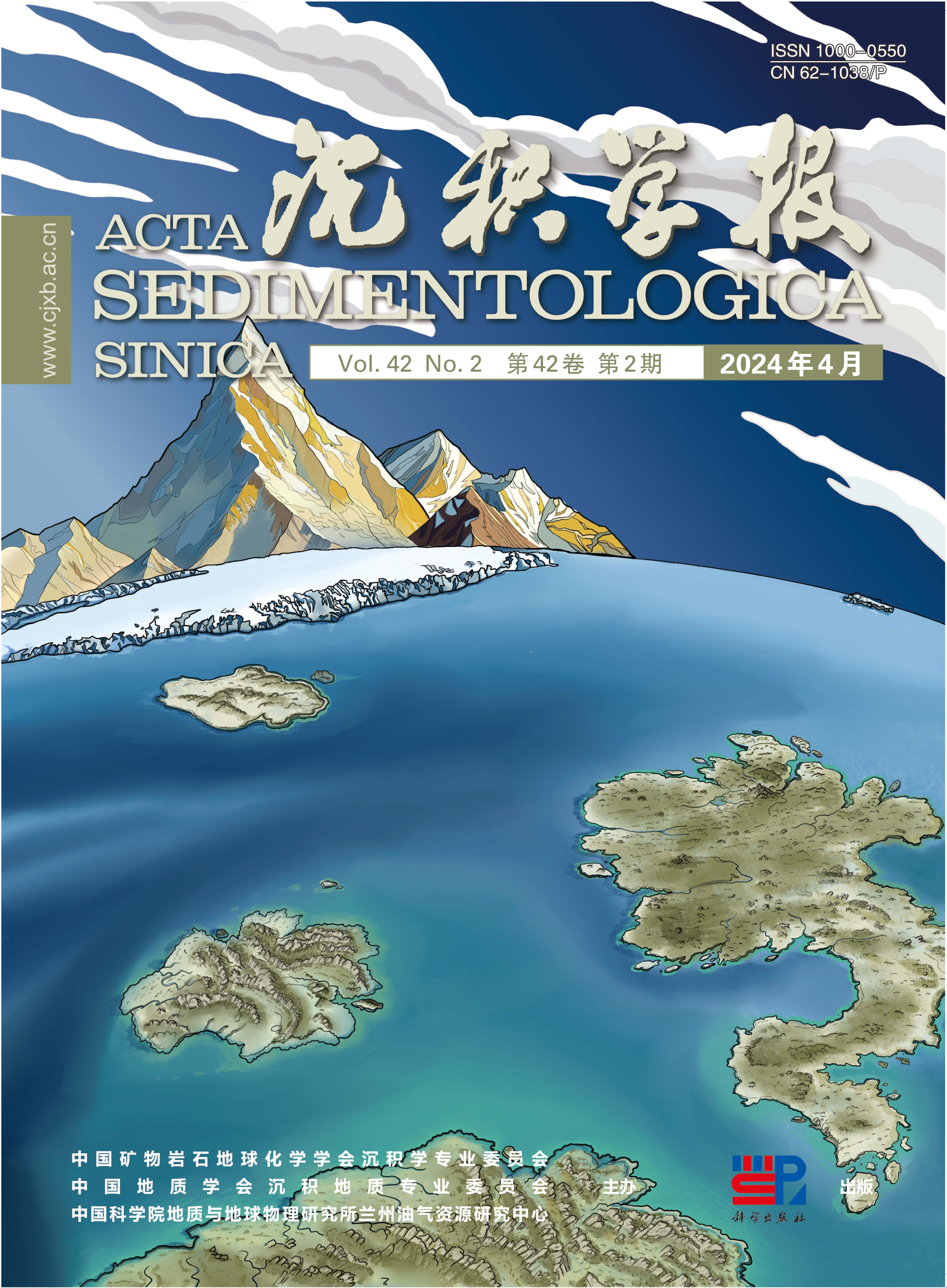


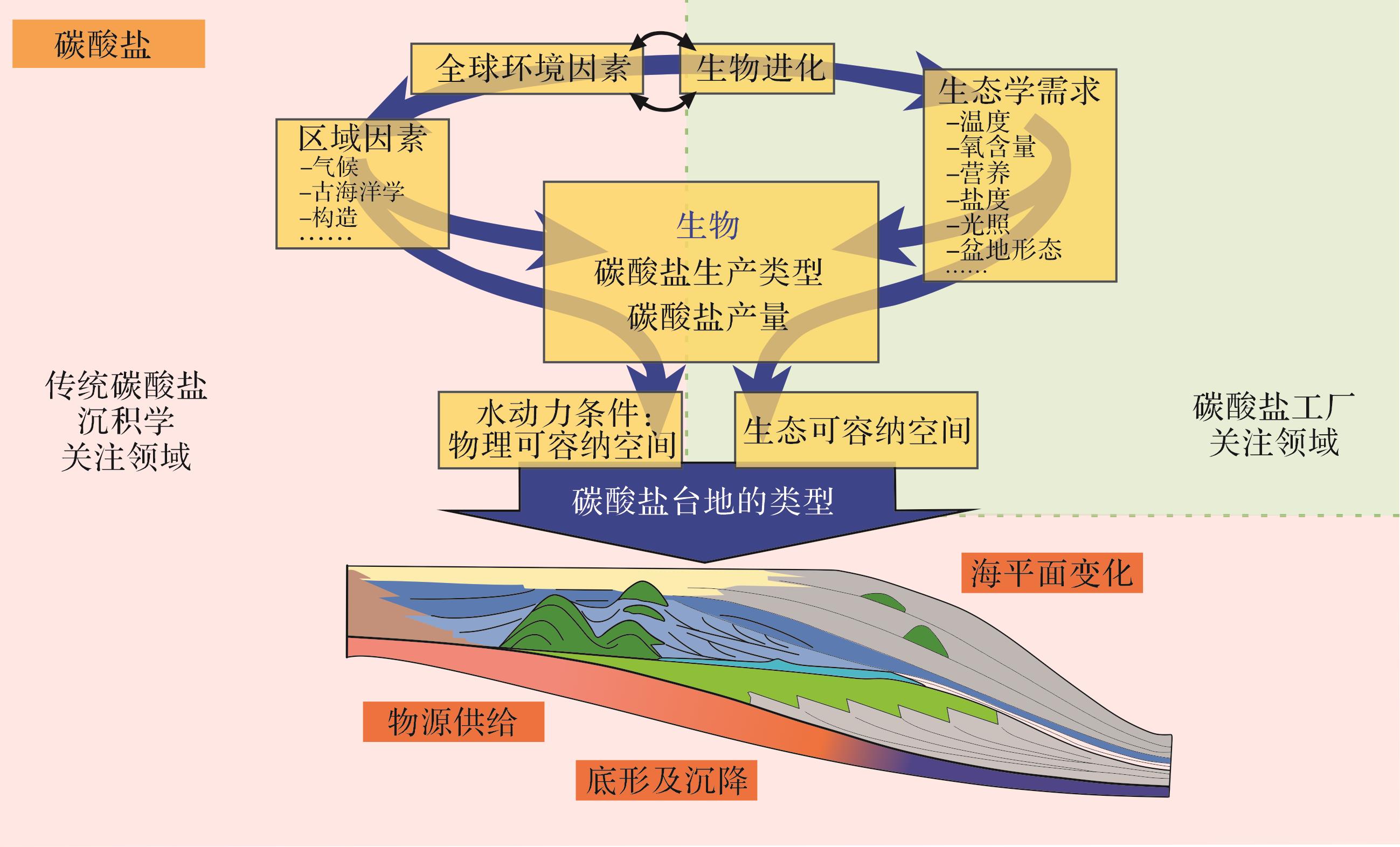





 DownLoad:
DownLoad:
